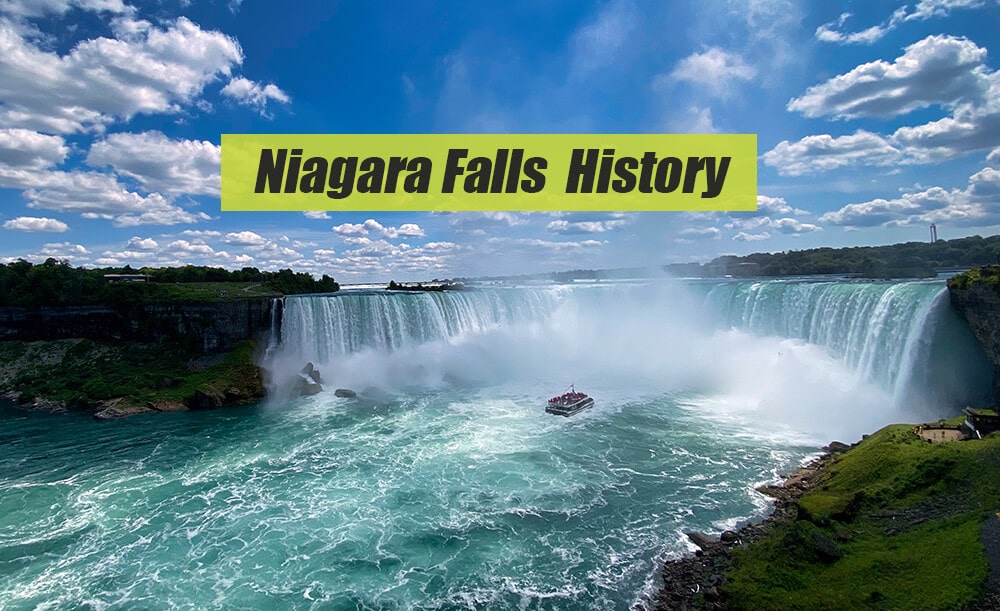
Table of Contents
Niagara Falls History and Formation
The history of Niagara Falls is a captivating tale. It traces back to the aftermath of the Ice Age when the Niagara River and The Great Lakes Basin were formed due to melting ice. Imagine, around 18,000 years ago, Southern Ontario was blanketed under dense ice that eventually melted, filling the basins with ancient “fossil water”, which remains scarce in replenishment even today. As the ice retreated northward 12,000 years ago, areas like Lake Erie, the Niagara River, and Lake Ontario became a magnet for its first settlers: the Clovis people, hunter-gatherers who nestled near Lake Erie, though their remnants are scant.
Fast forward to roughly 10,500 years ago, a series of geological shifts, including re-freezing and erosion, redirected the glacial waters. This resulted in a stark decrease in Lake Erie’s water levels and the Niagara River’s flow. But nature had other plans. After about 5,000 years, the waters rerouted through Southern Ontario, restoring the Lake, Falls, and River’s grandeur.
As forests flourished in Southern Ontario, hunter-tribes made their mark, ushering in the Archaic Period. One of the pioneering tribes was named “Onguiaahra”, believed to be the etymological root for “Niagara”.
Native Americans
Between 3000 to 300 years ago, the region of Southern Ontario was home to the influential Iroquois Native Americans. They are credited with introducing a rudimentary political system to Ontario, establishing villages, and creating a lasting cultural heritage, organized around clans overseen by an elected leader and bound by alliances. However, this era concluded with European incursions and was further impacted by internal strife.
As French explorers ventured into Niagara, they encountered two conflicting Native American tribes: the Iroquois and the Hurons. Alongside these two, there existed a harmonious group, known as the Neutrals, whose population ranged between 20,000 and 40,000 until the 1600s. This tranquil tribe significantly contributed to the region, introducing commerce, business, and artisanal skills.
The New World Era
In 1626, European exploration of Niagara began with the French explorer, Etienne Brule. This initial interaction with the “New World” spurred the establishment of trade routes and prompted the rise of commercial infrastructures on the American side of the river.
However, the bustling commercial activities were halted by the U.S. declaration of war on Canada in 1812. Due to its significant commercial value, Niagara-on-the-Lake became not only a strategic point of interest but also a central battlefield during skirmishes involving the U.S., British, and Canadian troops.
Post-war, recovery was gradual. Damaged homes were reconstructed, and Chippawa emerged as an industrial hub. In lieu of land-based transportation, the Welland Ship Canal, established in 1830, became the primary route. Furthering the area’s prosperity was the Niagara Harbour and Dock Company. Yet, the 1840s witnessed a decline, as the city’s core functions shifted elsewhere, leading to depopulation and a stunted industrial momentum.
The canal’s construction drew Irish immigrants, many of whom settled around Rye Street, also known as Irishtown. As recovery persisted, the first ferry services across the river began, and an alley connecting the port to a pivotal Canadian location was established, which later evolved into the tourism hotspot, Clifton Hill.
With the burgeoning interest in the region, transportation saw swift advancements. Numerous bridges spanned the river, and by 1841, a horse-drawn railway connected Chippawa and Queenston. A mere 13 years later, steam-powered wagons replaced these, serving the Town of Niagara Falls.
This transportation boon was paralleled by a surge in tourism. U.S. tourists flocked to the area, and the establishment of a religious camp in Chautauqua catalyzed the construction of both a hotel and amphitheater. Notably, in 1840, chemist Hugh Lee Pattinson captured the first-ever photograph of Niagara Falls.
A unique event occurred on March 29, 1848, when Niagara Falls’ flow came to a freezing halt. Massive ice formations obstructed the river, halting the flow to the Horseshoe Falls and occasionally freezing the river. This phenomenon, termed “The Ice Bridge,” became a sensational attraction for visitors.
By 1855, John August Roebling introduced the pioneering Niagara Falls Suspension Bridge, facilitating Canada-U.S. connectivity and trade with its tri-railway system.
The cascading waters of Niagara also paved the way for industrial innovation. Post-1869, following Nikola Tesla’s groundbreaking method to harness hydroelectric power for residential and commercial use, power plants sprouted on both riverbanks.
As time progressed, tourism solidified its place as the region’s primary industry. While boats were once the preferred means to experience Niagara Falls, the expanded rail and road networks ushered in a new era where visitors predominantly traveled by cars, trains, or buses.
FAQs
What is the history of Niagara Falls?
The formation of the Niagara River and The Great Lakes Basin was a consequence of the ice melting after the end of the Ice Age. 18 000 years ago, Southern Ontario was all covered with thick ice that was released and fulfilled the basins with “fossil water” which is almost not renewable to this day. 12 000 years ago, after the ice receded to the north, Lake Erie, the Niagara River and Lake Ontario began attracting the first inhabitants of these lands – the Clovis people who were mainly hunters living close to Lake Erie. They didn`t leave many traces to reveal more about their habits and living.
How did Niagara Falls get its name?
This period is known as Archaic Period. Niagara Falls got its name from the Iroquoian word "Onguiaahra," which means "The Strait." “Onguiaahra” was the name of one of the first tribes that settled in these lands. Over time, European settlers and explorers anglicized the word to "Niagara." The Iroquoian-speaking Native American tribes, specifically the Neutral Nation, originally inhabited the area around what is now known as Niagara Falls.
How far away can you hear Niagara Falls?
The roar of Niagara Falls can be heard from miles away, depending on weather conditions and the surrounding environment. Under favorable conditions, the sound of the falls can be heard up to 20 miles (32 kilometers) away.
